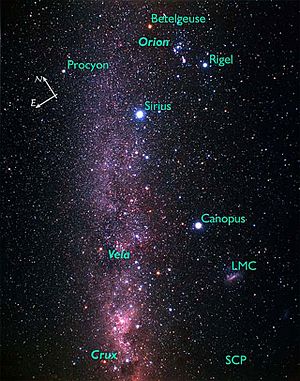Canopus facts for kids
Canopus is a very bright star. It is also called Alpha Carinae. It is the brightest star in its constellation, Carina. Canopus is also the brightest star you can see in the southern night sky.
Contents
How Far Away is Canopus?
For a long time, scientists did not know exactly how far away Canopus was. Before the 1990s, guesses ranged from 96 to 1200 light years. This was a very big difference!
It was hard to measure because Canopus is a special type of star. It is a "less luminous supergiant." These stars are rare and tricky to study.
In the 1990s, the Hipparcos satellite telescope helped. It found that Canopus is about 310 light years (or 96 parsecs) from our solar system. This was a big step in understanding this unique star.
How Bright and Big is Canopus?
Canopus is incredibly bright. It shines 13,600 times more brightly than our own Sun. It is the brightest star within about 700 light years of us.
If you were just one astronomical unit (the distance from Earth to the Sun) away from Canopus, it would look super bright. It would be much brighter than the Sun appears to us.
Canopus looks less bright than Sirius in our sky. This is only because Sirius is much closer to Earth. Sirius is only 8.6 light years away.
Canopus is also very big. Its diameter is about 0.6 astronomical units. This means it is 65 times wider than the Sun.
If Canopus were in the middle of our solar system, it would reach almost three-quarters of the way to Mercury. Imagine how huge that is!
For a planet to feel like it's getting the same amount of light from Canopus as Earth gets from the Sun, it would have to be super far away. It would need to be three times farther than Pluto is from our Sun.
What is Canopus Made Of?
The surface of Canopus is very hot, about 7350 degrees Kelvin.
Canopus also gives off strong X-rays. These X-rays probably come from its corona, which is like its outer atmosphere. This corona is heated to about 15 million degrees Kelvin by magnetic forces.
Canopus is part of a group of stars called the Scorpius–Centaurus Association. These stars all formed around the same time and in the same place.
Images for kids
See also
 In Spanish: Canopus (estrella) para niños
In Spanish: Canopus (estrella) para niños





